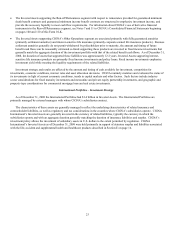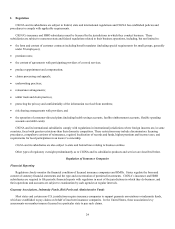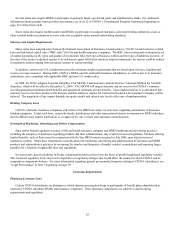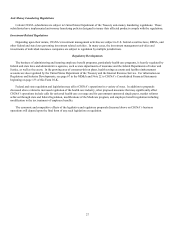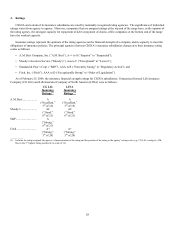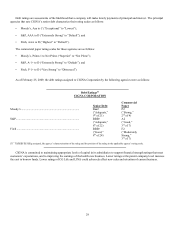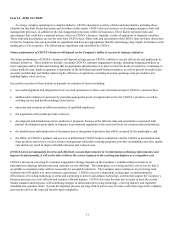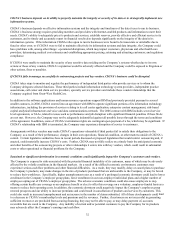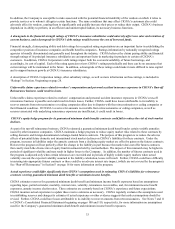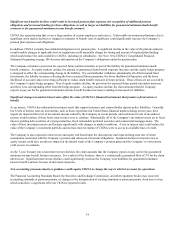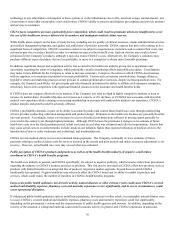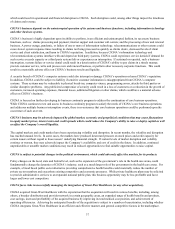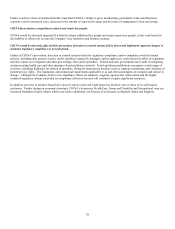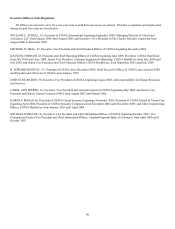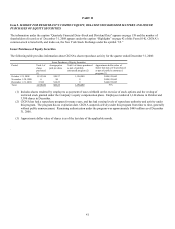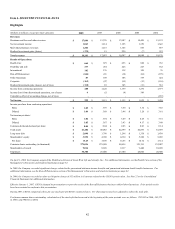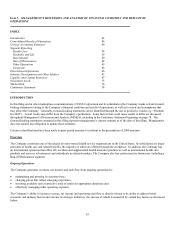Cigna 2008 Annual Report Download - page 53
Download and view the complete annual report
Please find page 53 of the 2008 Cigna annual report below. You can navigate through the pages in the report by either clicking on the pages listed below, or by using the keyword search tool below to find specific information within the annual report.33
In addition, the Company is susceptible to risks associated with the potential financial instability of the vendors on which it relies to
provide services or to whom it delegates certain functions. The same conditions that may affect CIGNA’s customers also could
adversely affect its vendors, causing them to significantly and quickly increase their prices or reduce their output. CIGNA’s business
depends on its ability to perform, in an efficient and uninterrupted fashion, its necessary business functions.
A downgrade in the financial strength ratings of CIGNA’s insurance subsidiaries could adversely affect new sales and retention of
current business, and a downgrade in CIGNA's debt ratings would increase the cost of borrowed funds.
Financial strength, claims paying ability and debt ratings by recognized rating organizations are an important factor in establishing the
competitive position of insurance companies and health benefits companies. Ratings information by nationally recognized ratings
agencies is broadly disseminated and generally used throughout the industry. CIGNA believes the claims paying ability and financial
strength ratings of its principal insurance subsidiaries are an important factor in marketing its products to certain of CIGNA’s
customers. In addition, CIGNA Corporation’s debt ratings impact both the cost and availability of future borrowings, and
accordingly, its cost of capital. Each of the rating agencies reviews CIGNA’s ratings periodically and there can be no assurance that
current ratings will be maintained in the future. In addition, a downgrade of these ratings could make it more difficult to raise capital
and to support business growth at CIGNA’s insurance subsidiaries.
A description of CIGNA Corporation ratings, other subsidiary ratings, as well as more information on these ratings, is included in
“Ratings” in Section J beginning on page 28.
Unfavorable claims experience related to workers’ compensation and personal accident insurance exposures in CIGNA’s Run-off
Reinsurance business could result in losses.
Unfavorable claims experience related to workers’ compensation and personal accident insurance exposures in CIGNA’s run-off
reinsurance business is possible and could result in future losses. Further, CIGNA could have losses attributable to its inability to
recover amounts from retrocessionaires or ceding companies either due to disputes with the retrocessionaires or ceding companies or
their financial condition. If CIGNA’s reserves for amounts recoverable from retrocessionaires or ceding companies, as well as
reserves associated with underlying reinsurance exposures are insufficient, it could result in losses.
CIGNA's equity hedge program for its guaranteed minimum death benefits contracts could fail to reduce the risk of stock market
declines.
As part of its run-off reinsurance business, CIGNA reinsured a guaranteed minimum death benefit under certain variable annuities
issued by other insurance companies. CIGNA maintains a hedge program to reduce equity market risks related to these contracts by
selling domestic and foreign-denominated exchange-traded futures contracts. The purpose of this program is to reduce the adverse
effects of potential future domestic and international stock market declines on CIGNA’s liabilities for these contracts. Under the
program, increases in liabilities under the annuity contracts from a declining equity market are offset by gains on the futures contracts.
However the program will not perfectly offset the change in the liability in part because the market does not offer futures contracts
that exactly match the diverse mix of equity fund investments held by contractholders. The impact of this mismatch may be higher in
periods of significant volatility and may result in higher losses to the Company. In addition, the number of futures contracts used in
the program is adjusted only when certain tolerances are exceeded and in periods of highly volatile equity markets when actual
volatility exceeds the expected volatility assumed in the liability calculation, losses will result. Further, CIGNA could have difficulty
in entering into appropriate futures contracts or there could be an adverse interest rate impact, (which are not covered by the program).
See “Run-off Reinsurance” in Section F on page 16 for more information on the program.
Actual experience could differ significantly from CIGNA’s assumptions used in estimating CIGNA’s liabilities for reinsurance
contracts covering guaranteed minimum death benefits or minimum income benefits.
CIGNA estimates reserves for guaranteed minimum death benefit and minimum income benefit exposures based on assumptions
regarding lapse, partial surrender, mortality, interest rates, volatility, reinsurance recoverables, and, for minimum income benefit
exposures, annuity income election rates. These estimates are currently based on CIGNA’s experience and future expectations.
CIGNA monitors actual experience to update these reserve estimates as necessary. CIGNA regularly evaluates the assumptions used
in establishing reserves and changes its estimates if actual experience or other evidence suggests that earlier assumptions should be
revised. Further, CIGNA could have losses attributable to its inability to recover amounts from retrocessionaires. See Notes 7 and 11
to CIGNA’s Consolidated Financial Statements beginning on pages 100 and 110, respectively, for more information on assumptions
used for the Company’s guaranteed minimum death benefit and minimum income benefit exposures.


